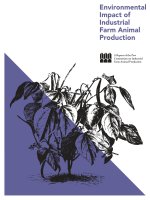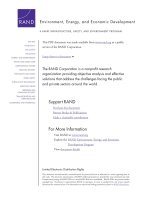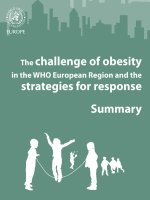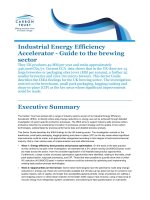The Environmental Performance of the European Brewing Sector ppt
Bạn đang xem bản rút gọn của tài liệu. Xem và tải ngay bản đầy đủ của tài liệu tại đây (920.41 KB, 52 trang )
The Environmental Performance
of the European Brewing Sector
KWA Bedrijfsadviseurs B.V.
KWA Bedrijfsadviseurs B.V. is a business consultancy company specialised in energy, water, soil, environment, health, safety
and quality. KWA has a lot of experience in the brewing sector. In 2000, 2004 and 2008 KWA carried out the World Wide energy
benchmark for the brewing sector. They advise (mainly Dutch) brewers on energy, water and cost reduction and they developed a
software tool for brewing companies to save energy and water.
Campden BRI
Campden BRI is the UK’s largest independent membership-based organisation carrying out research and development for the
food and drinks industry worldwide. It is committed to providing industry with the research, technical and advisory services needed
to ensure product safety and quality, process efficiency and product and process innovation.
A study commissioned by The Brewers of Europe
The Brewers of Europe is the trade confederation for the brewing sector in Europe and its voice towards the European institutions
and international organisations. Founded in 1958, it has 28 members, comprising 24 national brewer associations from the EU,
Croatia, Norway, Switzerland and Turkey.
Client number 12209
Report number 3101010DR02
May 2012
Project management:
J.H. Koop, KWA
Authors:
C. Donoghue, BRI
G. Jackson, BRI
J.H. Koop, KWA
A.J.M. Heuven, KWA
1
Foreword by the President of The Brewers of Europe 5
About the Study 7
Executive Summary 9
01. Water 12
1.1 Introduction 13
1.2 Water Sources 13
1.3 Water Consumption 14
1.4 Factors affecting Water Use 15
02. Energy and Greenhouse Gases 16
2.1 Introduction 17
2.2 Sources of Energy 17
2.3 Energy Consumption 18
2.4 Greenhouse Gases 20
03. Secondary Products 22
3.1 Introduction 23
3.2 Secondary Product Sources 23
3.3 Increasing the Value of Brewing 24
3.4 Alternative to Secondary Products 25
04. Waste and Wastewater 26
4.1 Introduction 27
4.2 Volume 27
4.3 Legislation 28
4.4 Minimising Environmental Impact 28
4.5 Wastewater Treatment Plants (WWTP) 28
05. Packaging 30
5.1 Introduction 31
5.2 Packaging Materials 32
5.3 Minimising Environmental Impact 33
5.4 Legislation 33
Conclusions 35
Annex I Methodology 37
Annex II Glossary 41
Notes 45
Table of Contents
Table of Contents 3
Glossary of Terms
Foreword
Foreword by the President of
The Brewers of Europe
Alberto da Ponte
President of The Brewers of Europe
I am delighted to welcome The Brewers of Europe’s first ever report on ‘The Environmental Performance of the European Brewing
Sector’. For thousands of years Europe’s brewers have relied on the highest quality ingredients of natural origin to brew beer.
This report highlights the steps we are taking to protect these important resources, improve our environmental performance and
ensure that brewers can continue to produce high quality beers in the many years to come.
In particular, this pan-European study shines a light on the important work that brewers across Europe are undertaking to decrease
water use, effluent output and CO
2
emissions. The report highlights that brewers are using fewer natural resources, producing
less waste and consistently reusing secondary materials such as brewers’ grains.
We are proud to launch the report during the European Commission’s Green Week 2012, whose theme is ‘Every Drop Counts -
The Water Challenge’ in order to highlight a 4.5% decrease achieved across the sector in water use per litre of beer produced. As
water makes up over 90% of beer, brewers must ensure an excellent supply and take steps to safeguard this resource.
Our efficiency efforts do not stop with water. Brewers have found innovative ways to save resources while producing the same
traditional product. The report notes that energy use decreased by 3.8% and CO
2
emissions decreased by 7.1%.
In November 2011, we welcomed European Commission President Barroso to our annual ‘Beer Serves Europe’ event. He stressed
that the Commission looks to our sector as a “key partner in pushing forward our growth agenda towards more smart, inclusive
and sustainable Europe.” I am very pleased to report that we are taking the necessary steps to help ensure a sustainable future.
This first report of its kind will be a platform for the brewing sector’s work in this area over the years and decades to come. We will
continue to innovate to ensure a sustainable future and to be environmentally responsible, also by doing what citizens have done
for years ‘reducing, reusing, recycling’. Through best practice sharing, innovation and hard work, the great steps taken can be
built upon further.
Foreword 5
About
the Study
Introduction
Brewers depend highly on the environment for resources, both in quality and in quantity. A high level of environmental awareness
is not only important to ensure that sufficient resources of high quality are available, both now and in the future, but also to
meet the general public’s environmental expectations. Therefore, The Brewers of Europe commissioned a study to describe the
environmental performance of the brewing sector in Europe.
This report presents the changes and trends in the environmental performance in the key areas over the years 2008 to 2010. This
quantitative data is supported and illustrated by a selection of prominent case studies.
Environmental performance
The environmental performance is examined by addressing the following key areas: water, energy and greenhouse gases,
secondary products, waste and wastewater, and packaging.
Water. Breweries use water in the product but it is also used for other purposes such as cleaning. The volume of water used per
hectolitre of product produced is an important indicator of environmental performance for the beverage sector.
Energy and Greenhouse Gases. Breweries use electricity and fuels to produce beer. There is a need to consider not only overall
energy usage, but also the successful application of “green energy” such as energy from renewable sources. Greenhouse Gases
are measured in carbon equivalents resulting from the energy used by the brewery.
Secondary Products. These are the outputs from the brewery other than beer. Secondary products include brewers’ grains,
brewers’ yeast, undersize malt particles, excess protein and brewers’ hops. These may then be used in other sectors e.g. as
cattle feed.
Waste and Wastewater. Waste is made up of outputs from the brewing products which are not beer and are not used as
secondary products. Wastewater is the water which is not beer and not usable for other purposes.
Packaging. Breweries use various materials for packaging. For example, bottles, cans and kegs. The type of packaging varies
from country to country, including whether packaging is recycled or reused
Relevant national contexts
The varying brewing landscape across Europe means that it is difficult to compare countries. Such variations include:
• The mix of beverage containers (e.g. returnable glass bottles require further heat & water consumption, PET impacts on
electricity etc.);
• The mix of beverages (e.g. water & soft drinks are not brewed, fermented or filtered, so leading to lower specific
consumption figures etc.);
• The restrictions of usage of ingredients (e.g. the German Purity law);
• The size of breweries (e.g. countries with a greater proportion of larger breweries may benefit from greater economies
of scale);
• The climate influences requirements re. heating and cooling;
• Technology status (modern equipment can save energy, but may require very significant investments).
Therefore, it is necessary to relate the specific consumption to those factors mentioned and to also consider the
spread of performances.
About the Study
About the Study 7
Executive
Summary
European brewers place a lot of emphasis on improving the sector’s environmental impact. They highly depend on the environment
for resources, both in quality and in quantity. A high level of environmental awareness is not only important to ensure that sufficient
resources of good quality are available, now and in the future, but also to meet the general public’s environmental expectations. To
this end, The Brewers of Europe commissioned a study to quantify key performance indicators and also to look for trends over the
period 2008 to 2010. Data on environmental performance was obtained from 156 breweries, representing 62% of the total beer
production volume (in 2010) in the 30 European countries approached (EU-27 plus Norway, Switzerland and Turkey). Responses
involved quantitative data plus narrative case studies from small breweries to national initiatives.
Key messages on the environmental performance
of the European brewing sector
Over the period 2008-2010:
Water
• 4.5% less water was used per hectolitre of beer produced, resulting in an equal decrease of wastewater output.
Energy and Greenhouse Gases
• 3.8% less energy was used for the production of each hectolitre of beer.
• Influence on the climate, measured as the combined Scope One and Two CO2 emissions, was reduced by a substantial
7.1%.
Secondary Products
• Overall biogas collected from secondary products and wastewater treatment increased by 7.0%.
• Certain secondary products, such as brewers’ grains and brewers’ yeast, were used as animal feed. Contributions to
animal feed have remained significant at 15.5 kg for every hectolitre of beer.
Waste and Wastewater
• The production of wastewater was reduced by 6.9% to 2.7 hl/hl beer produced.
• Biogas production increased by 7.0% to 92 m
3
/1,000 hl of beer produced.
Packaging
• The use of returnable glass bottles has decreased by 2% with a switch to non returnable (including recyclable) bottles,
cans, kegs and tank beer.
The trends in the report and a selection of case studies show the considerable steps taken by the brewing sector in Europe to
improve environmental performance.
Executive Summary
Executive Summary 9
Units 2008 2009 2010 change
Total Production in EU-27 + 3 Million hl 419 401 399 - 4.8 %
Production represented (including other beverages) % 64.1 64.8 64.8 + 0.7 %
Production represented which is not beer
‡ % 2.3 2.8 2.6 + 0.3 %
Water
Specific Water Consumption hl/hl† 4.4 4.4 4.2 - 4.5 %
Wastewater Production hl/hl† 2.9 2.8 2.7 - 6.9 %
Energy and Greenhouse Gases
Total direct energy MJ/hl† 121.4 119.5 116.8 - 3.8 %
Renewable energy % 5.0 4.8 5.3 + 0.3 %
Carbon emissions from brewery (Scope One) kg/hl† 4.9 4.7 4.6 - 6.1 %
Carbon emissions electricity usage (Scope Two) kg/hl† 3.5 3.3 3.2 - 8.6 %
Total carbon emissions (Scope One and Two) kg/hl† 8.4 8.0 7.8 - 7.1 %
Secondary Products
Animal Feed kg/hl† 15.6 15.2 15.5 - 0.6 %
Biogas Production m
3
/1,000 hl† 86 83 92 +7.0 %
Table 1: Key performance indicators of European brewing sector over the
time period 2008 - 2010
* Based on 2010 data when compared to 2008.
† Per hectolitre of beer produced
‡ In some production facilities beer is not the only beverage that is being produced. Data which was gathered represented all
beverage production. This table shows what was represented by other beverages so that the significance of beer production
can be seen.
10 Executive Summary
Water
01
• Reduction in specific water use was 4.5% over the three year timeframe of this study.
• On average, 4.2 litres of water was used to make one litre of beer. The range for aggregated national data
was from 2.5 to 6.4 litres of water for one litre of beer.
WATER RECOVERY
WATER SAVINGS
SABMiller’s Ursus breweries in Romania reduced
water consumption by 15%. This was achieved by
recovering water throughout the brewing process to
be used in cleaning processes that do not require
high quality water.
AB InBev Europe made a combined 4.1% reduction in water use in the period 2009-2010. This was attributed to recovery
of water for secondary use and optimisation of cleaning processes, while maintaining quality standards. Investments were
also made in new equipment to use less water.
The brewery also recognised that employee participation is important; employees at all levels are made aware of water
usage. All employees were invited to take part in discussions on water issues, such as the “Best Water Saving Ideas”
contest launched on World Water Day in March 2010. 356 ideas were collected to help reduce water consumption. The
winning idea in Leuven brewery saves 47,000 m
3
of water a year by narrowing the diameter of nozzles.
AB InBev has also partnered with the United Nations’ World Environment Day to focus on water conservation and watershed
problems. This involves working with governments, NGOs, communities and employees on water issues.
1.1 Introduction
Water is the most important raw material used by the brewing
sector. On average, water makes up about 92% of beer, with
ethanol and extract from raw materials making up the remaining
8%. Water is also used for cleaning, in steam production, as
cooling water and in heat exchangers for temperature control.
Water is equally a resource to local communities, hence why the
brewing sector has been successfully striving to minimise the
amount of water which is required to make beer.
1.2 Water Sources
Water comes from three main sources: groundwater, surface water and city (municipal) water. Groundwater is pumped from a
private well or borehole directly into the brewery. Surface water is sourced from rivers and lakes. Finally, city water comes from a
well or surface water source that supplies the local area. Figure 1.1 summarises the data for this study and shows the sources of
water used for brewing in Europe in 2010. Most water is sourced from well/borehole water (54%) or city water (42%) while 4% is
sourced from surface water.
The source of water can have an impact on the overall water use of a brewery since, depending on the source, additional
treatments may be needed.
Water
Water 13
Figure 1.1: Sources of Brewing Water for the Brewing Sector in Europe in 2010. Data gathered from the questionnaire.
1.3 Water Consumption
Figure 1.1. shows combined data for water consumption for breweries in Europe (expressed as percent change in hl of water/hl
of beer produced, compared against 2008 data). Data was gathered from the questionnaire.
There is an ongoing trend in the reduction of water used by breweries. The specific water consumption has dropped by 4.5% over
the timeframe of this study from 2008 to 2010 (figure 1.2). Specific water consumption aggregated from national production data
varied from 2.5 to 6.4 hl/hl with an average of 4.2 hl/hl in 2010.
WATER SAVINGS WATER USE BENCHMARK
Heineken Spain’s new brewery in Seville was built in
2008. The brewery produces 30% more than the old
brewery while using 30% less water and 25% less
electric and thermal energy. By staying close to the
city deliveries could still be made while travelling a
short distance but without causing any congestion.
The Deutscher Brauer-Bund (German Brewers
Association) has made several publications to its
members on minimising environmental impact
of water use. One publication involved a national
survey which benchmarked water use and costs
throughout Germany. Such benchmarking enables
breweries to compare their performance with others
and identify areas for improvement.
City Water (42%)
Well/borehole water (54%)
Surface Water (4%)
42%
4%
54%
Sources of Brewing Water in 2010
14 Water
WATER SOURCE
Brouwerij Lindemans sourced an average
of 80 m
3
of its water requirements a year
from rain water in 2008, 2009 and 2010.
A plan which is expected to re-use up to
1,000 m
3
of rain water a year has been
implemented, saving 4.3% of water usage
from other sources.
Figure 1.2: Combined water consumption (hl/hl) for breweries in Europe expressed as a percentage compared to 2008
reference data. Data gathered from the questionnaire.
1.4 Factors affecting Water Use
Overall water consumption in breweries is affected by several processes:
for example, the amount of water used for cleaning brewing equipment
and in the packaging process. Some water is lost as it is contained in
secondary products which leave the brewery. Pasteurisation can use
significant amounts of water. However, significant improvements have been
made in the pasteurisation process, where some breweries have moved
from tunnel pasteurisation to flash pasteurisation which uses less water.
Water consumption in breweries has been decreased through optimising
water usage and the introduction of new technology in all of the above
processes.
It is important to note that water consumption will also be significantly affected by, for example:
The packaging mix since this affects washing requirements; in general, single-trip glass bottles require less water usage
than returnable bottles. However, this phenomenon could not be distilled from the data of this study.
Incoming poor quality water will result in decreased efficiency and increased water losses from water treatment plants.
WATER SAVING TECHNOLOGY
Warsteiner Brewery made important water savings in the bottling process. It installed a Liquid Efficiency Spraying System
(LESS) which slows down pumps used on the bottling line for cleaning; cleaning takes place during periods when the
conveyor belt is temporarily stopped. Water usage was significantly lowered and savings were made.
Specific Water Consumption by Breweries in Europe
2008
80
90
95
85
100
2009 2010
Water Consumption (%)
Water 15
Energy and
Greenhouse Gases
02
• The total energy required to brew one litre of beer dropped by 3.8% to 116.8 MJ/hl (calculated on an LCV basis)
over the three year timeframe of this study.
• Total energy consumed by aggregated national data ranges from 70.6 MJ/hl to 234.1 MJ/hl.
• Renewable energy accounts for 5.3% of total energy consumption in Europe in 2010. Breweries can produce
biogas from wastewater and secondary products (such as the brewers’ grains).
• There was a 7.1% drop in Greenhouse Gas (GHG) emissions per hl of beer from 2008-2010. In some European
countries the opportunity for GHG reduction and renewable energy use is enhanced by the opportunity to trade
Green Certificates.
2. Energy and Greenhouse Gases
2.1 Introduction
Energy use is an important issue for the brewing sector and is one
of the most significant indicators for environmental performance.
It consists of electrical and thermal energy which together make
up total energy use. By improving energy efficiency both CO
2
emissions and the general environmental impact of brewing
are reduced. Energy is used for operating brewing equipment,
temperature control, non-brewing appliances and internal
logistics. The brewing sector is constantly striving to reduce
energy consumption and also to move towards using renewable
energy to run breweries. Some breweries now obtain 100% of
their energy and fuel from renewable sources.
2.2 Sources of Energy
The brewing sector receives most of its energy from non-
renewable sources but there is an increasing reliance on
renewable energy; the data in this survey shows that renewable
energy use increased from 5.0% in 2008 to 5.3% in 2010.
Common renewable energy sources are wind, solar, hydro and
biofuels. Some biofuels are produced on site in breweries which
makes breweries more self-sustainable while turning potential
wastes into valuable products. Breweries can also take wastes
from other industries to be used as energy sources, which have
an enhanced positive effect on the environment.
LEAN UTILITIES
Carlsberg breweries in Western Europe have
implemented a programme which minimises the
energy of the equipment used. The programme,
called “Lean Utilities”, uses efficiency measures such
as frequency at which machines are used during
low-season and setting personal targets for utility
consumption on the work floor. A 5% reduction in
energy consumption has been achieved since 2009.
The programme is expected to encourage more
significant reductions in energy consumption as it is
rolled out across the rest of Europe and best practice
techniques are shared among the group.
Looking beyond the breweries, Carlsberg has taken
further steps to reduce its environmental impact. A
warehouse in Denmark had relied on a dehumidifying
system to prevent labels getting wet and to stop bottle
caps from rusting. Originally the dehumidifying system
operated by drying the air inside the warehouse.
However, a new solution was implemented whereby
fresh air from outside the warehouse would be drawn
in to replace the humid air inside the warehouse. The
project was a massive success, drastically reducing
CO
2
emissions and costs.
Energy and Greenhouse Gases 17
2.3 Energy Consumption
In 2010, the average specific energy consumption of breweries was 116.8 MJ/hl (calculated on a LCV basis). This is a decrease
of 3.8% since 2008 (figure 2.1).
Combined Heat and Power (CHP) installations generated 9.6% of the
total electricity consumption in 2010. Data on the amount of biogas which
is used by the CHPs is not available. CHP in the brewing sector is a
promising prospect, with some breweries already moving to this source
of power.
Another example is the use of heat recovery systems in breweries. These
systems operate by capturing the heat from the steam produced by boiling
operations; the heat can then be reused for other processes. Another
example is the use of “wort-stripping” technology which increases the
speed of removal of unwanted compounds during wort boiling which can
result in the boiling process taking half the time, with reduced energy input
and reduced evaporation.
Further reductions in energy use come from improving refrigeration
systems in breweries; these are responsible for most of the electrical
energy consumption in a brewery. Having recognised this, the brewing
sector has focused on improving the efficiency of their cooling systems.
This has been achieved through pre-cooling of liquids that need to be
cooled down and the use of more efficient refrigerants. Ammonia is a
refrigerant growing in popularity in breweries due to its high efficiency and
the fact that it is not a greenhouse gas.
It is difficult to quantify the amount of renewable energy that is used since it is complicated by the different situations in different
countries. In some countries the use of Green Certificates is a suitable measure. However others, for example Norway, do not
employ Green Certificates because the majority of their electricity is from renewable sources.
Benchmarking of energy use can also be used to identify areas for improvement. There are breweries across Europe which
perform regular benchmarks, usually yearly, reflecting their intent to improve the energy efficiency of their processes.
EDUCATING EMPLOYEES
Heineken Italia recognised the significance
of educating employees in the importance
of environmental responsibility. An example
of this was a handbook which was
distributed to staff with information and
advice on how to improve energy efficiency
throughout the brewery. The handbook
also contained information on other
processes such as wastewater treatment
plants and CO
2
recovery. Educating
the employees helps them understand
why any changes are being made within
the brewery and encourages input for
further improvements.
Figure 2.1: Combined total energy consumption (MJ/hl) for breweries in Europe expressed as a percentage compared to
2008 reference data. Data gathered from the questionnaire.
Specific Energy Consumption by Breweries in Europe
Energy Consumption (%)
2008
80
90
95
85
100
2009 2010
18 Energy and Greenhouse Gases
RECTIFYING COLUMN
Alpirsbacher Klosterbrau installed a rectifying column on the wort boiler. Rectifying columns are usually associated with
the distilling process and increase the speed at which unwanted compounds are removed. The rectifying column is
compatible with almost any boiler. Total energy savings were 80% in the boiling process and 25% across the brewery.
Evaporation loss was also reduced to 2%, resulting in savings in water.
RENEWABLE ENERGY ENERGY SAVINGS
Clemens Härle brewery from Leutkirch produces all
of its beer from 100% renewable energy. It was the
first brewery in Germany to make all its beer from
green energy. Achieving this level of environmental
performance has been a gradual process carried
out over 15 years. The first step was producing a
document detailing a lifecycle assessment of the
brewery, which could then be used to formulate a
plan to move towards the ambitious goal.
Following a life cycle assessment, the decision
to use biodiesel as fuel for its twelve trucks and
four cars was made. The biodiesel was all to be
produced in Germany and did not compete with
food crops. The largest investment the brewery
made was the installation of a combustion plant
which used wood chips to provide all the brewery’s
heat. The combustion plant also provides heat for
five surrounding businesses. Photovoltaic panels
have also been installed on the plant, which make
up 12% of electricity requirements. The remaining
electricity requirements are purchased from
renewable sources including hydro, solar and wind.
In total the brewery has removed 900 tonnes of CO
2
emissions per year. The brewery’s business plan has
been honoured with rewards such as the German
Sustainability Award and the German Solar Prize.
Shepherd Neame brewery has taken some novel
approaches to reduce its environmental impact. The
first approach was the purchase of a modern boiling
system. It was the first brewery to install the system
which has resulted in shorter operating times, less
frequent cleaning and more consistent beer. Energy
has been reduced by 47% for every hectolitre
produced. Water consumption also dropped, as
has the effluent load in wastewater.
The second novel approach taken by Shepherd
Neame was providing a free bicycle to any employee
who lives within four miles of the brewery. This
resulted in a reduction of the carbon footprint of the
employees.
In addition a flash pasteuriser was installed in 2009
which decreased the heating requirements by 18%.
In the future changes are going to be made to the
refrigeration system by using ammonia as a coolant.
Ammonia is a very efficient coolant and has a Global
Warming Potential rating of zero.
Energy and Greenhouse Gases 19
2.4 Greenhouse Gases
The combustion of fuel results in the emission of greenhouse gases
(GHGs). CO
2
equivalents are calculated from energy use to enable
comparability of data. Two scopes are used to measure CO
2
equivalents.
Scope One is made up of all the greenhouse gas emissions caused
directly by a brewery such as burning fuel, excluding refrigerant losses
in this study. Scope Two is the emissions which result from electricity
purchased by the brewery. The data from this study has shown that the
brewing sector has steadily been decreasing CO
2
emissions (Figure 2.2)
This has been achieved through optimizing processes to use less fuel
and electricity and through using more environmentally friendly sources
of energy.
Scope Two is highly influenced by the trade in Green Certificates and
the specific CO
2
emission of the national electricity grid. Both Scope
One and Scope Two have been reduced in Europe. The data from this
study shows that there has been a reduction of 7.1% of CO
2
equivalents
(Scope One and Two combined) for every litre of beer produced from
2008-2010.
BEST AVAILABLE TECHNIQUES (BAT)
The brewing sector in Spain has produced a
comprehensive document of Best Available
Techniques (BATs). The brewing sector
and the Ministry of Environment combined
their expertise to design the most accurate
and up-to-date BATs possible. In addition
to providing guidance on best techniques,
the document also makes the point that
sustainable management is important to be
included in any economic growth plan and
should be a factor in any decisions going
forward. Further benefits of BAT documents
are that they can be used as common
reference resources to make realistic
commitments to environmental targets
in the future.
Figure 2.2: Change in Scope One and Two CO
2
equivalents (kg/hl) for breweries in Europe measured as a percentage
compared to 2008 reference data. Data gathered from the questionnaire.
Scope One and Two CO
2
Emissions
2008
80
85
90
95
100
2009 2010
Scope One and Two Emissions
Scope One
Scope Two
20 Energy and Greenhouse Gases
SUSTAINABILITY COMMITMENTS
NATIONAL PROGRAM BELGIUM
The British Beer & Pub Association (BBPA) represents the brewing sector in the UK. One of the BBPA’s most important
objectives is supporting the reduction of energy and water use in the brewery. This has been carried out since the 1970s.
In 2010 the BBPA published a report entitled Brewing Green - Our Commitment Towards A Sustainable Future for Britain’s
Beer which has 10 focus points relating to sustainability. The report also contains benchmarking trends since 1990, targets
for up to 2020 and has case studies from some of the best performing breweries.
The Belgian breweries through the ‘Belgian Brewers’ federation are also member of the Belgian Federation of the Food
Industry (Fevia). Through Fevia Belgian breweries take part in two energy agreements at regional level: “Benchmarking
Convenant Energie Vlaanderen” (Flanders) and “Accord de Branche Wallonie” (Wallonia). In addition, the ‘Belgian Brewers’,
in collaboration with Fevia, carried out a benchmarking project of energy use (gas and electricity) in the breweries situated
in Flanders. Fifteen member-breweries participated, of which one received a free energy audit that helped the brewery in
question to improve its energy efficiency. Furthermore, the results of the benchmarking project, together with solutions for
how to improve the energy efficiency, were presented to all breweries.
Energy and Greenhouse Gases 21
Secondary
Products
03
3. Secondary Products
3.1 Introduction
Although beer is the main product, there are also several other valuable products (called secondary products) which may be
produced in the brewing process. The brewing sector has a long tradition of looking for the most valuable applications of such
products; this reduces waste, has benefits to local markets and limits the waste produced by breweries to primarily wastewater
and packaging waste.
3.2 Secondary Product Sources
The most important sources of secondary products are brewers’
grains, brewers’ yeast and surplus beer.
Brewers’ grains comprise the materials which remain after starch has
been solubilised from grains
Brewers’ yeast is used for fermenting beer and during the fermentation
process the yeast multiplies several times. A portion of this is reused
in subsequent fermentations but large amounts remain available for
other uses.
Surplus beer is produced from unavoidable beer losses throughout
the brewing process; this is still a valuable product and may be used
to enhance animal feed.
Other, less significant, sources of secondary products are brewers’
hops and trub (proteins) which are formed at different stages of
brewing.
ENERGY SAVINGS
Plzenský Prazdroj brewery took a holistic
approach to its environmental impact in 2010.
It used evaporated liquid CO
2
for cooling glycol
and water. This combined with shortening
and insulating steam pipes has led to an 8%
reduction in energy consumption per hl of beer
produced. Emissions have also reduced by light
weighting packaging and making use of rail
transport to distribute its beer.
The brewery also collaborated with a local
University to create a tool for making best use
of its secondary products. It is currently being
used for the Plzeský Prazdroj brewery and if
successful will provide a blueprint from which
other breweries can work.
• Data from the breweries which participated in this study showed that 15.5 kg of brewers’ grains was used as
animal feed for every hectolitre of beer produced in 2010.
• By utilising potential waste as secondary products breweries can minimise waste going to landfill.
Secondary Products 23









